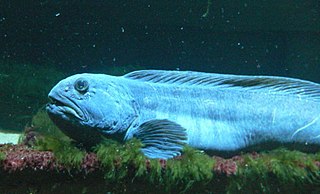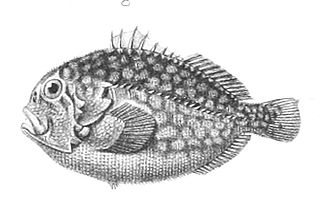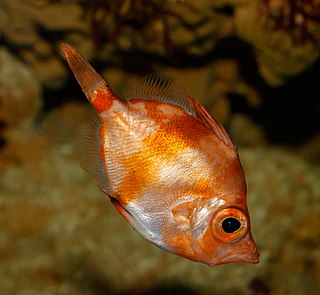
The Percidae are a family of ray-finned fish, part of the order Perciformes, which are found in fresh and brackish waters of the Northern Hemisphere. The majority are Nearctic, but there are also Palearctic species. The family contains more than 200 species in 11 genera. The perches and their relatives are in this family; well-known species include the walleye, sauger, ruffe, and three species of perch. However, small fish known as darters are also a part of this family.

Anoplopomatidae, the sablefishes, are a small family of ray-finned fishes classified within the order Scorpaeniformes. This family is the only family in the monotypic superfamily Anoplopomatoidea. These fishes are found in the North Pacific Ocean.

The Moronidae is a family of percomorph fishes, commonly called the temperate basses, in the order Moroniformes. These fishes are found in the freshwaters of North America and the coastal waters of the North Atlantic.

Caproidae, or boarfishes, are a small family of marine fishes comprising two genera and 19 species. These fishes are found throughout the world in temperate and tropical seas.

Hexagrammidae, the greenlings, is a family of marine ray-finned fishes belonging to the suborder Cottoidei in the order Scorpaeniformes. These fishes are found in the North Pacific Ocean.

Ephippidae is a family of percomorph fishes, the spadefishes, in the order Moroniformes. These fishes are found in the tropical and temperate oceans of the world, except for the central Pacific.

Antigonia is a genus of marine ray-finned fish belonging to the family Caproidae, the boarfishes. This genus is found in the warmer oceans around the world and is the only extant genus in the subfamily Antigoniinae.

Congiopodidae, commonly known as pigfishes, horsefishes and racehorses, is a family of ray-finned fish classified with in the order Scorpaeniformes. These fishes are native to the Southern Hemisphere.

Anarhichadidae, the wolffishes, sea wolves or wolf eels, is a family of marine ray finned fishes belonging to the order Scorpaeniformes. These are predatory, eel shaped fishes which are native to the cold waters of the Arctic, North Pacific and North Atlantic Oceans.

Pholidae is a family of marine ray-finned fishes, known as gunnels, in the scorpaeniform suborder Zoarcoidei. These are fishes of the littoral zone and are mainly found in North Pacific Ocean, with two species found in the North Atlantic Ocean and Arctic Ocean.

The Hemitripterinae is a subfamily of the scorpaeniform family Agonidae, known as sea ravens or sailfin sculpins. They are bottom-dwelling fish that feed on small invertebrates, found in the northwest Atlantic and north Pacific Oceans. They are covered in small spines.

Peristediidae, the armored sea robins or armoured gurnards, is a family of ray-finned fishes belonging to the suborder Platycephaloidei in the order Scorpaeniformes. They are found in the deep water in the tropical and warm temperate of the world's oceans.

Emmelichthyidae is a small family of small to medium-sized marine ray-finned fishes known commonly as rovers, bonnetmouths or rubyfishes.

Caracanthus, the coral crouchers, or orbicular velvetfishes, are a genus of ray-finned fishes. They live in coral reefs of the tropical Indo-Pacific. This genus is the only member of the monotypic subfamily Caracanthinae, part of the family Scorpaenidae.

Platycephaloidei is a suborder of ray-finned fishes, part of the order Scorpaeniformes, and includes the flatheads, ghost flatheads and sea robins.

Hoplichthys, the ghost flatheads, is a genus of marine ray-finned fishes native to the Indian and Pacific Oceans. This genus is the only member of the family Hoplichthyidae.

Capros aper, the boarfish or Zulu fish. is a species of marine ray-finned fish belonging to the family Caproidae. It is the only species in the monospecific genus Capros. The boarfish is found in the northeastern Atlantic Ocean and the Mediterranean.

Minous, is a genus of marine ray-finned fishes, it is the only genus in the tribe Minoini, one of the three tribes which are classified within the subfamily Synanceiinae within the family Scorpaenidae, the scorpionfishes and their relatives. They are commonly known as stingfishes. They are found in the Indo-West Pacific.

Choridactylini, commonly known as stingfishes, stingers or ghouls, is a tribe of venomous ray-finned fishes classified within the subfamily Synanceiinae, the stonefishes, part of the family Scorpaenidae, the scorpionfishes and their relatives. These fishes are found in the Indo-Pacific.

Opisthocentrinae is a subfamily of marine ray-finned fishes, classified within the family Stichaeidae, the pricklebacks or shannies. These fishes are found in the North Pacific Ocean.



















